Instead of raining yesterday as the front came through, the sky slowly cleared from the west, and today dawned chilly and clear. While Richard worked on fence, I put on rubber boots and went out to see if anything’s drying out yet.
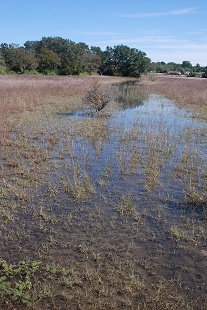
Certainly not this part of it. In fact, there’s standing or flowing water over much of the 80 acres. And no, it’s not the same image as the one in the previous post–it’s just as wet if not wetter.
There’s also some gorgeous color: prairie flameleaf sumac at its peak.
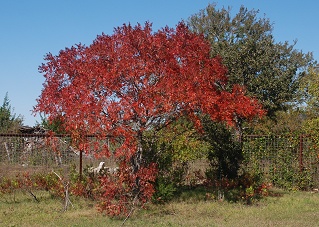
Notice the small ones near it…if we’re lucky this thicket will fill the corner of the north horse lot.
We have an exuberant Cecile Brunner rose at the low end of the horse lot, too–planted to disguise an old brush/trash pile. To keep the horses from getting into the pile, or it, we fenced around it with old gates and panels, and it’s now filled the space. After all the rain, it’s covered with pale pink flowers.
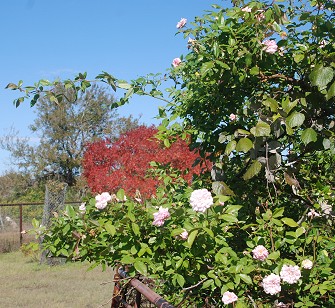
Yes, that’s the same sumac behind it.
Down in the creek woods, the main color was gold–the eastern persimmons have big butter-yellow leaves:
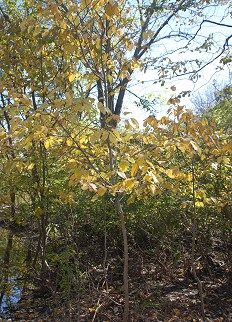
That’s a corner of the “lower swamp overflow” on the left, reflecting a bit of blue sky.
One of my purposes in going out was documenting the effects of all this rain after drought–where there’s been erosion, or soil deposition, aquatic life-forms (if I can spot them) returning to the place, signs (tracks) of other wildlife, etc, etc. I also did some trail maintenance with a hand pruner, re-opening the trail west from Deer Ford, trimming a bit of the trail from the low end of the gully system to the cottonwood tree (not possible to go farther due to high water), checking the rock crossing of Westbrook (need to add more rocks!) , and trimming around Owl Pavilion’s deck. Lots of tracks, heard lots of winter birds that have moved into the SW meadow cover. Westbrook jumped its banks near the old cottonwood and formed a new channel still draining briskly, parallel (roughly) and west of the former one.
But for the moment, here’s another beauty: partridge pea in bloom (very valuable native forb!)
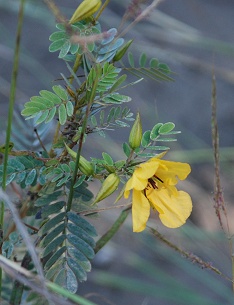
We have only a small population of patridge pea, near the foot of the gully system, so I was very glad indeed to see that several plants were doing well and blooming.
Lots of odes were mating and ovipositing, though mostly three species: Common Bluets, Variegated Meadowhawks, and Common Green Darners.
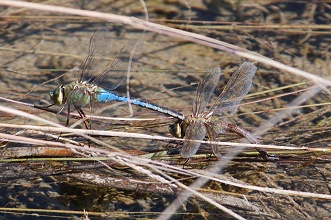
Here’s a pair of Darners ovipositing in one of the pools in the west gully system.
Comment by cdozo — October 30, 2009 @ 7:37 pm
What a lovely walk. Thanks for sharing. That partridge pea is so pretty. I hope I find some of those on my land.
It took me quite a few years to appreciate autumn in Texas. I used to go find some sumac and stare at it. But now I see signs of fall at the beginning of September. I like the fall flowers and the rainy cold fronts that barrel through.
I still miss New England, but not as much. I’m hoping the Big Tooth Maples I bought in Medina will help. I plan on bringing one home every year or so. So someday there will be a Lost Maple Grove on my land. The trees will turn colors in the fall and make me a little less homesick.
Comment by source.of.all.trouble — October 30, 2009 @ 9:02 pm
Is this sumac the one many folks are allergic to? We have some on our property, but it doesn’t seem to be so tall as yours.
Since we have no maples, we depend on the sumac for our red fall color. Since we’re originally from Michigan, the browns and yellows only seem bland.
Comment by elizabeth — October 30, 2009 @ 9:35 pm
Our big tooth maple looked gorgeous last year, C. Check your soil pH…you may also be able to grow the Caddo maple that grows in East Texas (it doesn’t like very alkaline soil, but it can stand heat. Ours is turning color right now, just starting.
Comment by elizabeth — October 30, 2009 @ 9:44 pm
No, not if you’re thinking of poison sumac. Depending on where you are, you might have prairie flameleaf (this one) or smooth sumac–both give good red autumn color. Flameleaf can be anything from hip-high on up to (our largest) 20 feet tall, in an old stand that’s protected. There was a patch in a field near here that someone left alone, covering at least half an acre–making a fiery mound in autumn. But developers routinely bulldoze it. It grows taller with a good water source–in another field with a seasonal drainage, there was a lot, beautiful every year, but the landowner decided to “channelize” the drainage and ‘dozed it all out. Stupid. It’s a preferred habitat for some birds. There’s also the smaller, shade-loving aromatic sumac (small leaves of a totally different shape) that turns a deeper red.
Our red stuff includes the sumacs, poison ivy, Virginia creeper, rusty blackhaw viburnum (rich red), roughleaf dogwood (purply but glowing deep rose in backlight), red oaks (every shade from orange to wine-red–each tree is different.) Plus the various red berries–snailseed early on, then possumhaw. There may be some other reds you could add to supplement your sumacs.
Comment by Patsy Webb — November 3, 2009 @ 4:14 pm
I really enjoyed “visiting” your beautiful 80 acres. You are doing a wonderful job.
Comment by elizabeth — November 3, 2009 @ 4:18 pm
I’m glad you enjoy the pictures & chat. I just got in from outside, where I wished there were a way to photograph the clouds of American Snout butterflies flitting around the top of the KRB seedheads. All I got was blurs or pictures of a single one perched.